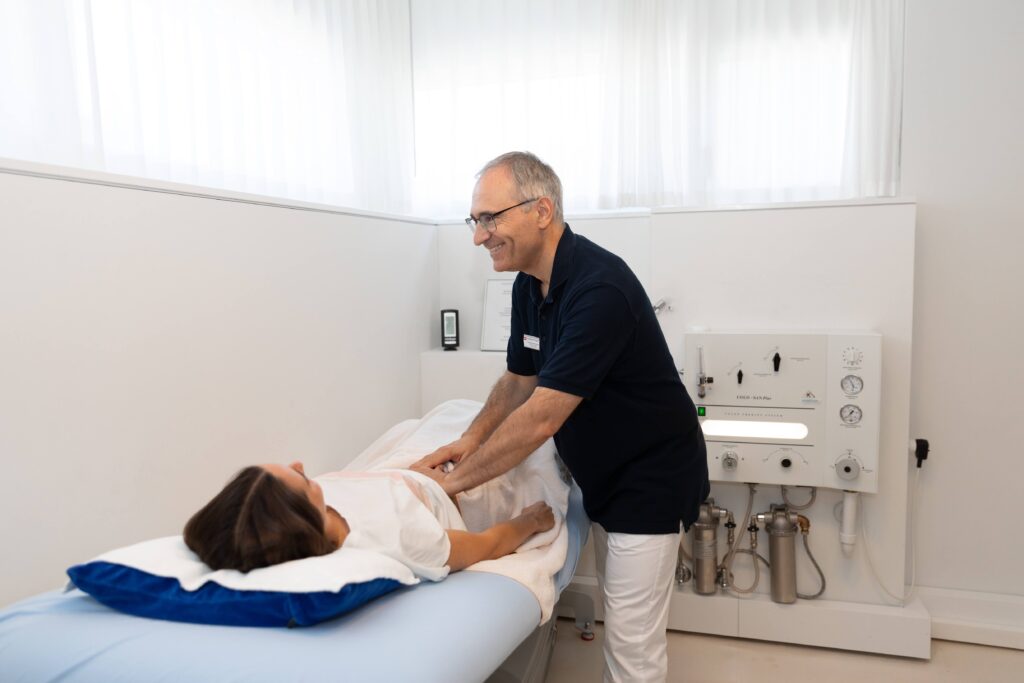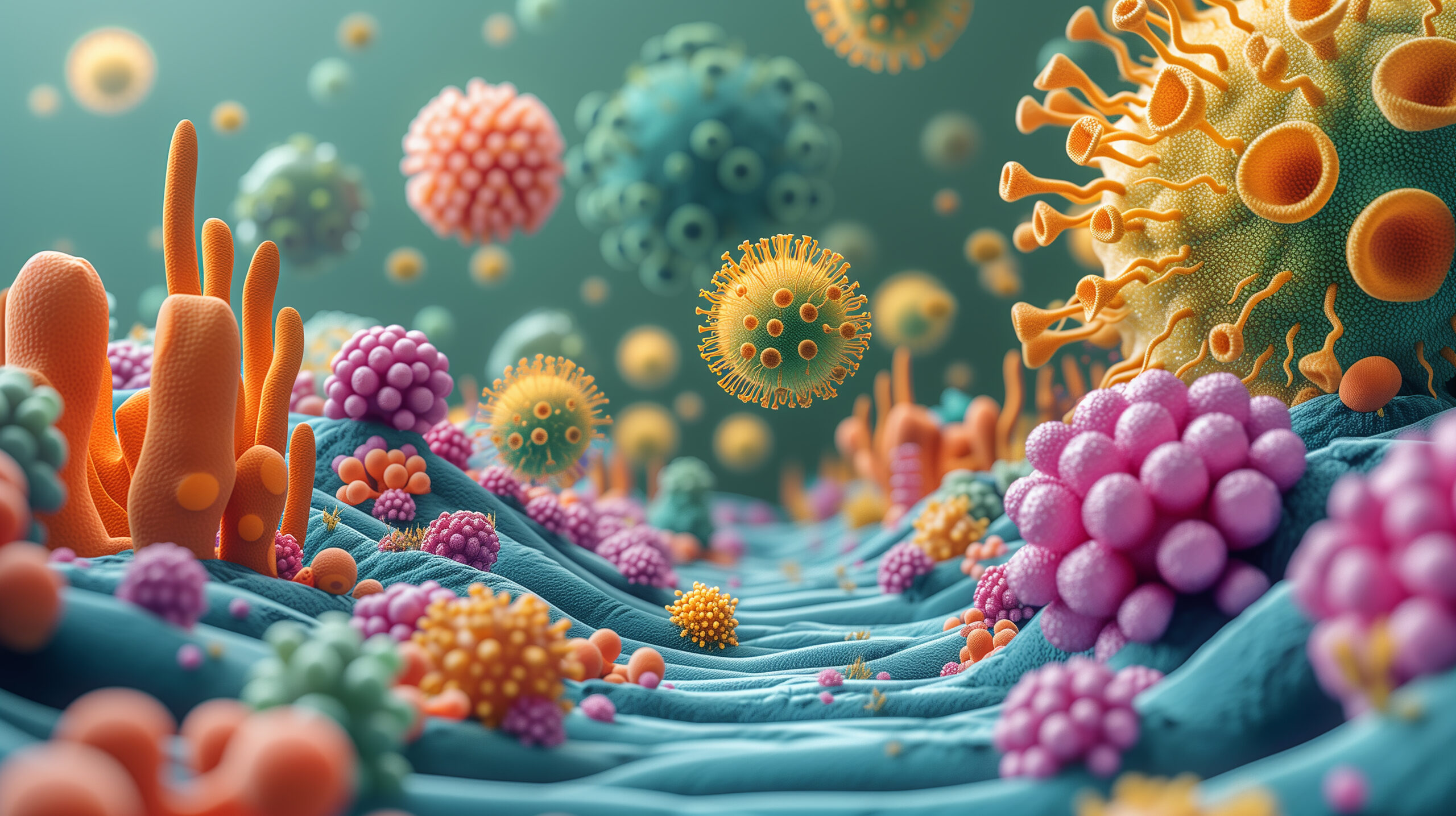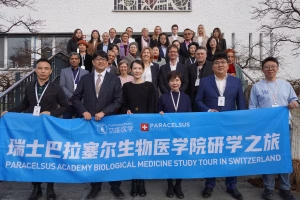What was once tenderly referred to as gut flora is increasingly being termed the microbiota. These are the wonderful inhabitants of our intestines that, in peaceful coexistence with us, have provided us with everything we couldn’t produce ourselves or needed to convert from food. Conversely, we’ve cared for our gut flora by consuming plenty of fibre-rich foods, fresh vegetables, fruits, and unprocessed freshly prepared meals. Over centuries, friendly cooperation between the bacteria in our mouths, intestines, on our skin, and body cells was nurtured.
While the previously estimated ratio of 10:1 in favour of bacteria to body cells was propagated, the new estimate now lies in the ratio of 1:1 (1). Without becoming too philosophically of contemplating who we are in the face of the sheer number of co-existing bacteria, we can recognize how essential our fellow inhabitants are for our health.
In the past, the ratio of bacteria to body cells was estimated to be 10:1, but today it is assumed to be 1:1 (1). Without getting too philosophical – who are we really – we can recognize how essential our roommates are for our health.
Functions of the Gut Flora
While some functions of the gut flora have long been known, modern research continuously reveals new aspects of its importance. Particularly exciting is the immense potential found in microbiological and epigenetic research. Understanding the genes of our microorganisms opens up ground-breaking possibilities for future therapeutic approaches.
Here are some of the old and newly discovered remarkable functions of the microbiota:
1. Digestion and Nutrient Absorption
The microbiome aids in digesting foods that our digestive system alone cannot process. It supports the fermentation of carbohydrates and fibres and produces short-chain fatty acids (SCFAs) like butyrate, which serves as an energy source for intestinal cells and has a neurological effect via the gut-brain axis (2). It plays a role in regulating satiety and contributes to neuronal health by reducing inflammation and supporting intestinal barrier function (3).
2. Synthesis of Vitamins and Nutrients
Certain gut bacteria synthesize vitamins such as Vitamin K and several B vitamins (biotin, folate, riboflavin).
3. Immune System Modulation
The microbiome plays a central role in the development and function of the immune system. It aids in the maturation of immune cells and antibody production. It also contributes to maintaining the integrity of the intestinal barrier and prevents the invasion of pathogenic microorganisms.
4. Protection Against Pathogens
The microbiome competes with pathogenic microorganisms for nutrients and binding sites in the intestine, known as “colonization resistance”. This prevents the overgrowth and infection by harmful germs.
5. Metabolism Regulation
- Microorganisms in the gut regulate metabolism, including fat storage and glucose metabolism. Changes in the microbiome can be associated with metabolic disorders such as obesity and type 2 diabetes (4,5). Certain bacterial species, such as Bacteroidetes and Firmicutes, are known to play a crucial role in these processes. Water-soluble fibres and bitter substances also contribute to metabolic regulation by promoting the growth and activity of these beneficial bacteria.
6. Inflammation Regulation
The microbiome produces anti-inflammatory substances that prevent chronic inflammation and are associated with various diseases, including inflammatory bowel diseases (IBD).
These substances include:
Short-chain fatty acids (SCFAs): Butyrate, propionate, and acetate are SCFAs that arise from the fermentation of fibres by gut bacteria and have anti-inflammatory effects (6).
Secondary bile acids: These are modified by gut bacteria and may have anti-inflammatory effects.
Tryptophan metabolites: These metabolites, produced by gut bacteria, can modulate inflammation and strengthen intestinal barrier function (7).
7. Detoxification and Breakdown of Toxins
Certain microbes break down harmful substances and carcinogens, reducing the risk of certain diseases.
8. Influence on Brain Health and Behavior
The gut microbiome communicates with the central nervous system via the gut-brain axis and can produce neurotransmitters and other neuroactive substances that influence the brain and behaviour. Research suggests that the microbiome may play a major role in neurological and psychiatric disorders.
Diversity of Gut Bacteria for Quality of Life in Aging
These diverse functions of the microbiome highlight its central importance in our treatments at the Paracelsus Clinic. Research in this field continually reveals new insights into how the microbiome contributes to human physiology and health. Particularly noteworthy is the role of gut bacteria diversity in quality of life as we age. A study by the University College Cork in Ireland shows that greater diversity of microbiota is associated with a higher quality of life, better health in ageing, robust immune defence, and lower incidence of inflammatory diseases (8).
A study by University College Cork in Ireland shows that a greater diversity of microbiota is associated with a higher quality of life and better health in old age. People with a higher diversity of gut bacteria have better physical and mental health, more robust immune defenses and a lower incidence of inflammatory diseases (8, 9).
Significance of Gut Flora for Epigenetics
The importance of diverse gut flora extends not only to overall health and well-being in aging but also to its influence on epigenetics, which controls gene expression without altering the DNA sequence itself.
Dr. Bruce Lipton and other scientists emphasize that epigenetics is more important than DNA itself in regulating biological processes. While humans have only slightly more genes than a roundworm (approx. 20,000-25,000 genes in humans versus 19,000-20,000 genes in a roundworm), epigenetic mechanisms allow for complex functions and adaptations. These mechanisms are heavily influenced by the cell’s environment, especially the milieu outside the cell and the cell membrane.
The gut microbiota plays a key role in this process by producing biochemical signals that regulate epigenetic changes. For example, short-chain fatty acids, such as butyrate, which are produced through the fermentation of dietary fibres by gut bacteria, can induce epigenetic changes. They can influence the activity of enzymes that regulate DNA methylation, thereby modulating gene expression (6, 9, 10). Targeted gut restoration can thus induce positive epigenetic changes that have anti-inflammatory effects, modulate metabolism, and promote mental health (9, 10, 11).

Protecting the Gut Flora
Recognizing the many positive health properties, it’s crucial to consider how important it is to protect the microbiome. This includes not only the diversity of gut flora itself but also the integrity of the intestinal mucosa and the well-being of all microbes. When we consider the external world as a mirror of the internal world, we find fewer and less types of flowers blooming in their full glory, expressing their full diversity. More often, we encounter monocultures, depleted soils, pesticide-treated soils, and so forth.
The interaction of this microbial community plays a crucial role in chronic diseases. At Paracelsus, we therefore recommend measures to promote a healthy gut flora and focus on therapies aimed at supporting and maintaining gut health.
The microbiome can be protected by the following factors:
Avoiding Toxins and Chemicals
Avoiding pesticides, heavy metals, nicotine, and chemical substances from medications can help heal and rebalance the microbiome. These harmful substances can disrupt the bacterial balance in the gut, kill beneficial bacteria, and damage the intestinal mucosa.
We also observe with concern the increasing cultivation of genetically modified foods. While the industry focuses on increasing yields, herbicide tolerance, and changing the composition of sunflower oil, for example, the health effects are not always prioritized. At the Paracelsus Clinic, we specialize in removing a wide range of environmental toxins from the gut and the entire organism. Through specific supplements, infusions, whole-body hyperthermia, physical applications, and hydro-colon therapy, we succeed in reducing the burden and healing the gut.
Adequate Physical Activity
Regular exercise promotes a healthy microbiome, while lack of exercise increases the risk of dysbiosis. This is because physical activity improves intestinal blood flow, stimulates intestinal motility, and releases anti-inflammatory substances. Additionally, exercise supports the immune system and helps reduce stress, which can negatively affect the microbiome. An old saying goes: “After eating, you should rest (stress reduction) or take 1,000 steps“.
Adequate Good Sleep
Inadequate or irregular sleep patterns can affect the microbiome. Studies have shown that sleep deprivation can alter the composition of gut bacteria, potentially leading to health problems. Some factors for sleep quality include enough sunlight, exercise outdoors during the day, and avoidance of blue light in the evening. All sources of electromagnetic radiation (WiFi routers, mobile phones, DECT phones, Bluetooth…) should be turned off at night.
Microbiome and Chronic Diseases
Certain infections and chronic diseases, such as inflammatory bowel diseases, can directly harm the microbiome. These conditions can disrupt bacterial balance and impair microbiome function.
In recent years, we have seen a significant increase in inflammatory bowel diseases, as well as food intolerances, irritable bowel syndrome, etc. Since the immune system is closely linked to the gut, caring for and protecting our gut flora is immensely important.
Considering that the gut flora is also responsible for producing messengers to the brain, we must recognize that influencing the microbiome towards monoculture makes our thinking and feeling one-sided. Often, we have to rely on our gut feeling to guide us – another reason to preserve the diversity of our co-thinkers.
At the Paracelsus Clinic, you have the opportunity to have your microbiome examined. Simultaneously, the permeability of the intestine (leaky gut), inflammation, the immune system, and the function of pancreatic enzymes (digestion) can be assessed. Food intolerances can be tested, and conclusions can be drawn about the internal milieu in dark field microscopy.
Therapeutically, you have a whole spectrum of treatment options available that address all the above-mentioned topics. Biofilm treatment has already been described in a previous newsletter. Extremely valuable is colon hydrotherapy as it deeply penetrates and relaxes the autonomic nervous system in addition to its detoxifying effect.
Promotion of Health through Colon Hydrotherapy
Colon hydrotherapy is a gentle and effective method for cleansing the colon and plays a significant role in the biological medical treatment of chronically ill individuals. This therapeutic approach aims to support colon health, alleviate liver burden, strengthen the autonomic nervous system, improve the internal milieu, and enhance lymphatic flow. Our therapists undergo rigorous training in colon hydrotherapy to ensure the treatment is carried out optimally, providing the greatest health benefits.
Professional Therapeutic Massage
During colon hydrotherapy, intestinal massage is an integral part of the treatment. Our therapists are trained in targeted massage techniques to promote the mobilization of residual stool and stimulate bowel peristalsis. These massages help to alleviate hardened or stagnant areas in the colon, optimizing the cleansing process.
Probiotic Enemas
Another important aspect of our treatment is re-floriation, where a bolus of probiotic bacteria is introduced during the colonic. These beneficial bacteria contribute to restoring the natural balance of the gut flora, both quality and diversity. This method ensures that the colon is not only cleansed but also immediately colonized with beneficial microorganisms.

The Key Role of the Microbiome
Promoting gut health is a crucial component of the holistic treatment of chronic diseases. By restoring intestinal health, we address the roots of many problems, positively affecting the liver, immune system, internal milieu, metabolism, autonomic nervous system, central nervous system and lymphatic flow.
Even for prevention by cultivating the microbiota, we can reduce the incidence of inflammatory diseases and achieve an overall higher quality of life. Thus, our therapies support one of the most important pillars of our patient’s health.
With a combination of detoxification, diet and regeneration, we offer a holistic and effective treatment method that goes well beyond simple colon cleansing.
Imagine a flourishing flower meadow thriving with life, beauty, and diversity.
We welcome you at Paracelsus Clinic in Switzerland.
References:
- Sender R., Fuchs S., & Milo R. (2016). Revised estimates for the number of human and bacteria cells in the body. PLOS Biology.
- Stilling R. M., et al. (2016). The neuropharmacology of butyrate: The bread and butter of the microbiota-gut-brain axis? Neurochemistry International, 99, 110-132.
- Gao Z., et al. (2009). Butyrate enhances the intestinal barrier by facilitating tight junction assembly via activation of AMP-activated protein kinase in Caco-2 cell monolayers. J of Nut, 139(9), 1619-1625.
- Qin J., et al. (2012). A metagenome-wide association study of gut microbiota in type 2 diabetes. Nature, 490(7418), 55-60.
- Ley R. E., et al. (2006). Microbial ecology: human gut microbes associated with obesity. Nature, 444(7122), 1022-1023.
- Koh A., et al. (2016). From dietary fiber to host physiology: short-chain fatty acids as key bacterial metabolites. Nature Communications, 7, 10514.
- Rooks M. G., & Garrett, W. S. (2016). Gut microbiota, metabolites and host immunity. Nat Rev Immune, 16(6), 341-352.
- Jeffery I. B., et al. (2016). Diverse and rich microbiota linked to quality of life in aging individuals. Nature.
- Sonnenburg, E. D., & Sonnenburg, J. L. (2014). Diet-induced extinctions in the gut microbiota compound over generations. Nature.
- Trompette A., et al. (2014). Gut microbiota metabolism of dietary fiber influences allergic airway disease and hematopoiesis. Nature Medicine, 20(2), 159-166.




